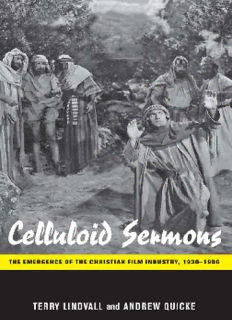
Celluloid Sermons: The Emergence of the Christian Film Industry, 1930-1986 PDF
Preview Celluloid Sermons: The Emergence of the Christian Film Industry, 1930-1986
Celluloid Sermons This page intentionally left blank Celluloid Sermons The Emergence of the Christian Film Industry, 1930–1986 Terry Lindvall and Andrew Quicke a NEW YORK UNIVERSITY PRESS New York and London NEW YORK UNIVERSITY PRESS New York and London www.nyupress.org © 2011 by New York University All rights reserved References to Internet websites (URLs) were accurate at the time of writing. Neither the author nor New York University Press is responsible for URLs that may have expired or changed since the manuscript was prepared. Library of Congress Cataloging-in-Publication Data Lindvall, Terry. Celluloid sermons : the emergence of the Christian film industry, 1930–1986 / Terry Lindvall and Andrew Quicke. p. cm. Includes bibliographical references (p. ) and index. ISBN 978–0–8147–5324–8 (cl : alk. paper) — ISBN 978–0–8147–5325–5 (ebook) 1. Christian films—United States—History and criticism. 2. Motion picture industry— United States—History—20th century. 3. Motion pictures—Religious aspects— Christianity. 4. Motion pictures in Christian education. 5. Christianity in motion pictures. I. Quicke, Andrew. II. Title. PN1995.9.C49L56 2011 791.43’682773—dc23 2011018456 New York University Press books are printed on acid-free paper, and their binding materials are chosen for strength and durability. We strive to use environmentally responsible suppliers and materials to the greatest extent possible in publishing our books. Manufactured in the United States of America 10 9 8 7 6 5 4 3 2 1 Dedicated to Lisa and Tim Robertson, for their bountiful generosity and artistic vision in supporting the cinema arts. Deus Gloria. In Memoriam Ken Curtis (1939–2011) This page intentionally left blank Contents Preface ix Abbreviations xvii 1 God Talks 1 2 Evangelical Film Auteurs 25 3 Methodist and Ecumenical Films 56 4 Reformed and Dissenting Images 92 5 The Studio Era of Christian Films 116 6 The Master Filmmakers 144 7 Mark IV and Apocalyptic Film 171 8 Global Film Evangelism 188 9 Conclusion: A Modest Renaissance before the End 203 Appendix: Chronology of Christian Film History 219 Notes 223 Selected Bibliography 259 Index 263 About the Authors 270 | vii This page intentionally left blank Preface If Shakespeare could see sermons in stones, we of today ought to be able to see sermons in pictures. —Thomas Opie1 The hostility and antipathy that some groups expressed toward Hol- lywood in the 1930s seethed through the pages of the evangelist Robert Sum- ner’s Hollywood Cesspool.2 The book catalogued a legion of immoral deeds on the screen and within the Hollywood community, citing divorces, adulteries, murders, and other crimes against humanity and God.3 In recognition of his critique of the American entertainment business, Sumner received an hon- orary doctorate from Bob Jones University in Greenville, South Carolina, a fundamentalist Christian university. That Christian fundamentalism would castigate the Hollywood industry, even during the days of collective studio censorship, is no surprise. What might be unexpected is that the same fun- damentalist institution that lauded Sumner’s critique of the entertainment industry would build a significant film program of its own and make credible films for its own audiences. Respectable dramatic features would roll out of the university under the oblique, even self-effacing, imprimatur of Unusual Films. The unexpected development of an underground movement of religious pictures offers an odd revelation, a mixing of oil and water, of God and Mam- mon. In 1939, the film historian Margaret Thorp stumbled on peculiar coop- erative ventures of churches and theaters, finding drive-ins near Los Ange- les that offered their exhibition facilities to all churches for Sunday services during any part of the day. She discovered movie theater managers in Wil- kes-Barre, Pennsylvania, who promoted a “go to church on Easter Sunday campaign,” and in Elroy, Wisconsin, film exhibitors who arranged a special screening of the 1938 Norman Taurog film Boys Town for all the local clergy. For Thorp, however, the acme of cooperation occurred in Thomasville, Georgia. When a Gypsy Smith revival tent hit the town, the local exhibitor recommended the revival meetings over his own shows, declaring that Mr. | ix
Description: